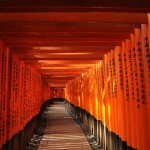
The intriguing history and beautiful traditions of Kyoto, the cultural capital of Japan, stretch back over 12 centuries, but how does a first-time visitor choose which to see among the
Kyoto’s 1,600 Buddhist temples and 400 Shinto shrines?
April Orcutt describes her first trip to Japan and the seven temples that were her favorites – and each one is distinctly different.
- Fushimi Inari Shrine: “Torii gates” are rectangular arches made of three logs, and over 5,000 vermillion torii gates arch over paths in the hills behind this Shinto shrine dedicated to Inari, the god of rice, sake and, in recent years, business enterprises. Stone and bronze statues of foxes, thought to be Inari’s messengers and located throughout the grounds, carry symbolic keys to granaries in their mouths. Walking beneath the closely spaced gates grouped along several miles of trails with the sun illuminating their vivid red-orange hues while listening to birds sing in the surrounding trees is one of my favorite memories of Japan.
- Kinkaku-ji or Temple of the Golden Pavilion: Sure, this one’s

Japanese school children mug for the camera during their trip to Kinkaku-ju (the Golden Pavilion) in Kyoto, Japan. (© April Orcutt. All Rights Reserved)touristy, but the shining gold leaf covering to top two floors of this three-story Zen Buddhist temple and reflecting in the pond attracts your eye away from the crowds. It’s hard to imagine that Kinkaku-ju was originally constructed nearly 600 years ago by a shogun, but it has been rebuilt over the years. A bonus here: I was highly entertained by watching the Japanese school children play around on their field trips to these beautiful grounds.
- Kiyomizu-dera or Pure Water Temple: Buddhist pilgrims drink water from a sacred spring here, but the expansive temple grounds hold numerous other intricately carved and brightly painted pagodas. The view from here covers all of Kyoto to the mountains on the opposite side of town. (The trees that frame the main temple were barren in winter so a better time to visit would be spring with cherry blossoms, summer with green leaves or fall with autumn colors.)
- Ryoan-ji or Temple of the Peaceful Dragon: The focus at this Zen Buddhist temple is on its famous sand garden where 15 rocks were placed in a very particular arrangement in a “sea” of white pebbles. The rectangular garden is about 75 feet long and 30 feet wide, and the intention is for visitors and pilgrims to engage in quiet contemplation. I saw a number of people there who did seem to be in a state of meditation.
- Ginkaku-ji or Temple of the Silver Pavilion: Alas, the Silver Pavilion is not covered in silver – although the shogun who built the original building as his retirement villa over 500 years ago had intended to do so. This Zen Buddhist temple is now known more for its beautiful landscaping with ponds and a small constructed waterfall, for trails that wander through the lush gardens and up onto the hill above the temple, and for the meticulously raked “sand gardens” including what may represent Mt. Fuji. (I got a kick out of the street that leads up the hill to the entrance to the temple grounds because it’s lined with shops selling souvenirs, gifts, ice cream and “spiral French fries” called “potatornados.”)
- Kodai-ji Temple: No flashy colors here – the exteriors of the temples and pagodas on these grounds are in shades of white and brown and blend harmoniously into the gardens. However, inside you’ll see ceilings covered in bright colors and gold leaf. I especially liked walking down the path that led down from the upper temple through a peaceful bamboo forest. The courtyard next door features a seated Buddha that must be at least 40 feet tall.
- Kangaan Temple: While this temple was lovely with a small white-rock garden and a number of intriguing rooms to check out, what made it special was that it’s now a restaurant – and the vegetarian cuisine was some of the best food I had in Kyoto.
- You can read more about Kangaan in Marybeth Bond’s post about “Top Five Quirky Things to Do in Kyoto, Japan”:
Photo captions:
Looking through the long rows of torii gates at the Fushimi Inari Shrine in Kyoto, Japan, on a sunny day is stunning. (© April Orcutt. All Rights Reserved)
Japanese school children mug for the camera during their trip to Kinkaku-ji (the Golden Pavilion) in Kyoto, Japan. (© April Orcutt. All Rights Reserved)